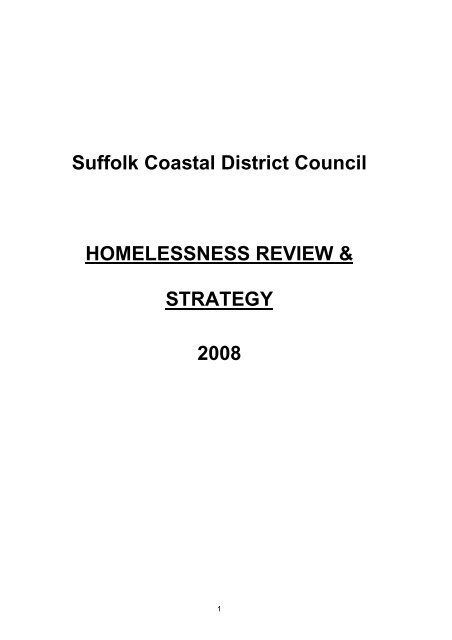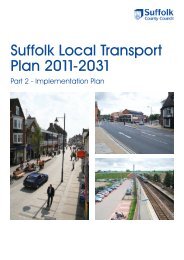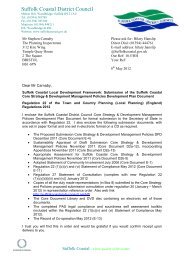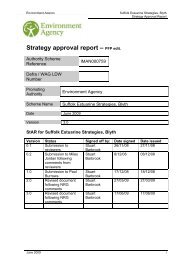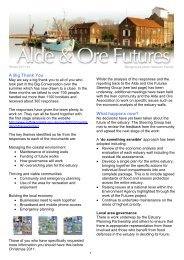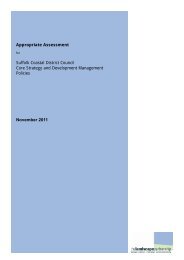Suffolk Coastal District Council HOMELESSNESS REVIEW ...
Suffolk Coastal District Council HOMELESSNESS REVIEW ...
Suffolk Coastal District Council HOMELESSNESS REVIEW ...
You also want an ePaper? Increase the reach of your titles
YUMPU automatically turns print PDFs into web optimized ePapers that Google loves.
<strong>Suffolk</strong> <strong>Coastal</strong> <strong>District</strong> <strong>Council</strong><br />
<strong>HOMELESSNESS</strong> <strong>REVIEW</strong> &<br />
STRATEGY<br />
2008<br />
1
INDEX<br />
Page<br />
INTRODUCTION 3<br />
METHODOLOGY 3<br />
CORPORATE AIMS<br />
AND OBJECTIVES 3<br />
REGIONAL ISSUES<br />
Sub-regional Strategy<br />
Choice Based Lettings 4<br />
LINKS WITH OTHER<br />
STRATEGIES<br />
<strong>REVIEW</strong><br />
Housing Strategy<br />
Community Strategy and LSP<br />
Gypsy and traveller Strategy<br />
Greater Haven Gateway Strategy<br />
Private Sector Housing Renewal Strategy<br />
<strong>Suffolk</strong> <strong>Coastal</strong> Crime & Disorder Strategy<br />
Supporting People Strategy<br />
Current Provision<br />
What has changed since the last review?<br />
Support Provision<br />
What can we do better?<br />
7<br />
9<br />
CURRENT<br />
FUTURE NEED<br />
&<br />
Population<br />
Stock<br />
Housing Need<br />
Homelessness in <strong>Suffolk</strong> <strong>Coastal</strong><br />
- Homelessness Presentations and Acceptances<br />
- Reasons for Priority Need<br />
- Main Causes of Homelessness<br />
- Housing Advice Outcomes<br />
- Households in Temporary Accommodation<br />
14<br />
CORE ISSUES<br />
National Levels<br />
Local Levels<br />
Summary of Main Issues identified<br />
User feedback<br />
18<br />
<strong>HOMELESSNESS</strong><br />
STRATEGY<br />
Strategic Aims<br />
Action Plan<br />
- Prevent homelessness occurring<br />
- Secure permanent housing solutions for all<br />
- Manage the use of B & B and temporary<br />
accommodation effectively<br />
- Increase awareness of Housing Options to all<br />
users and partners<br />
- Increase ‘life chances’ for vulnerable young<br />
people<br />
Monitoring the effectiveness of the strategy<br />
How to comment on this review<br />
20<br />
2
1. INTRODUCTION<br />
Under the Homelessness Act 2002 s.1 (3), housing authorities were required to publish<br />
their first Homelessness Strategy by 31 July 2003. Section 1(4) requires a new strategy,<br />
based on the results of a homelessness review, to be published within 5 years.<br />
The review has to consider:<br />
1. the levels and future levels of homelessness in the area<br />
2. what action is being taken to :<br />
• prevent homelessness<br />
• ensure accommodation is or will be available for people who may become<br />
homeless<br />
• provide support for those who are or may become homeless or who have<br />
been homeless previously and need support to prevent it happening again<br />
3. The resources available to the housing authority, the social services authority,<br />
other public authorities and voluntary organisations for these actions to take<br />
place.<br />
The aim of the review is to gauge the extent of homelessness in the district, assess<br />
future need, and establish what is currently being done and by whom, to prevent and<br />
tackle homelessness.<br />
The review has to take account of all forms of homelessness within the meaning of the<br />
1996 Act, not just those who are unintentionally homeless and in priority need under Part<br />
7 if the Act.<br />
2. METHODOLOGY<br />
In order to develop this strategy the following steps have been taken:<br />
• Workshop undertaken with front line staff to discuss performance against<br />
previous aims and ideas for the way forward<br />
• Consultation day with voluntary and statutory agencies, partnering organisations,<br />
relevant local authority departments and staff<br />
• Actions from 2003 strategy reviewed<br />
• Interviews undertaken with service users in temporary accommodation who are<br />
receiving tenancy support<br />
• Telephone and face to face interviews undertaken with sample of service users to<br />
understand and identify any gaps in service provision<br />
• Needs mapping exercise to show current and likely future levels of<br />
homelessness in the area and reasons for homelessness<br />
• Joint working arrangements reviewed<br />
• Core issues identified<br />
• Sub regional strategy group set up to promote common goals and approaches<br />
3. CORPORATE AIMS AND OBJECTIVES<br />
The homelessness strategy links in to the authority’s strategic aims. Housing is one of<br />
the six key aims identified in the <strong>Council</strong>’s vision for the <strong>District</strong> and seeks to ‘encourage<br />
the improved provision of, and access to appropriate housing to meet existing and future<br />
3
need’. A Balanced Scorecard approach is in place to determine priorities at corporate<br />
level and this is then fed down to individual targets to ensure that aims are achieved.<br />
The key objectives which link into the Corporate and Homelessness Team scorecard<br />
are: -<br />
- Prevent Homelessness occurring<br />
- Secure permanent housing solutions for all<br />
- Manage use of B & B and temporary accommodation effectively<br />
- Increase awareness of Housing Options for all users and partners<br />
- Increase ‘life chances’ for vulnerable young people<br />
4. REGIONAL ISSUES<br />
<strong>Suffolk</strong> <strong>Coastal</strong> is part of the Greater Haven Gateway housing sub region. The housing<br />
sub region comprises Babergh, Braintree, Colchester, Ipswich, Maldon, Mid <strong>Suffolk</strong>,<br />
<strong>Suffolk</strong> <strong>Coastal</strong> and Tendring borough and district councils. By working together, we can<br />
ensure that all our Strategies have the same basic elements and give consistency<br />
throughout the region. This will make comparisons easier and enable sharing of good<br />
practice and joint working. Savings can also be made on staff training.<br />
Sub regional strategy<br />
One of the aims of the Greater Haven Gateway housing sub region is to ensure best<br />
value and best practise by working together on issues that impact on more than one<br />
authority. Homelessness prevention is one of these issues.<br />
The following tables show how homelessness in the <strong>Suffolk</strong> <strong>Coastal</strong> <strong>District</strong> compares to<br />
other authorities in the sub region. There will always be variances due to the different<br />
make up of the authorities, for example, if the area is more rural and if there are other<br />
facilities to attract people to the area.<br />
Homeless Acceptances 2006/07<br />
Tendring<br />
<strong>Suffolk</strong> <strong>Coastal</strong><br />
Mid-<strong>Suffolk</strong><br />
Maldon<br />
Ipswich<br />
2006/07<br />
Colchester<br />
Braintree<br />
Babergh<br />
0 50 100 150 200 250 300 350 400<br />
(All data on homelessness acceptances is from HSSA, Communities website)<br />
4
The rate of homelessness acceptances shows a general downward trend over time.<br />
Homeless Acceptances between 2002 and 2007<br />
Tendring<br />
<strong>Suffolk</strong> <strong>Coastal</strong><br />
Mid-<strong>Suffolk</strong><br />
Maldon<br />
Ipswich<br />
Colchester<br />
2006/07<br />
2005/06<br />
2004/05<br />
2003/04<br />
2002/03<br />
Braintree<br />
Babergh<br />
0 100 200 300 400 500 600<br />
This becomes clearer if the sub-regional picture is viewed.<br />
Homelessness acceptances for the<br />
sub region<br />
numbers<br />
2500<br />
2000<br />
1500<br />
1000<br />
500<br />
0<br />
2002/03 2003/04 2004/05 2005/06 2006/07<br />
year<br />
There is also a clear downward trend in the number of families living in temporary<br />
accommodation, which shows progress towards the government’s target of halving the<br />
number of families living in temporary accommodation by 2010.<br />
5
Families in Temporary Accommodation<br />
Tendring<br />
<strong>Suffolk</strong> <strong>Coastal</strong><br />
Mid-<strong>Suffolk</strong><br />
Maldon<br />
Ipswich<br />
Colchester<br />
2006/07<br />
2005/06<br />
2004/05<br />
2003/04<br />
2002/03<br />
Braintree<br />
Babergh<br />
0 50 100 150 200 250 300 350<br />
Whilst the figures are showing an improvement, it is evident that further work is needed<br />
to ensure that there is suitable move on accommodation available. This will help<br />
households to settle into permanent accommodation as quickly as possible and lessen<br />
the financial impact on each authority.<br />
At the same time total lettings of social housing show a general increase in available<br />
lettings since 2002/03. There has been a marked increase in lettings for Colchester over<br />
this period. This may reflect the introduction of Choice Based Lettings (CBL) in the<br />
Borough which helps to create community stability. If people choose where they want to<br />
live they are more likely to stay there longer.<br />
6
Total Social Lettings<br />
Tendring<br />
<strong>Suffolk</strong> <strong>Coastal</strong><br />
Mid-<strong>Suffolk</strong><br />
Maldon<br />
Ipswich<br />
Colchester<br />
2006/07<br />
2005/06<br />
2004/05<br />
2003/04<br />
2002/03<br />
Braintree<br />
Babergh<br />
0 200 400 600 800 1000 1200 1400 1600<br />
Choice Based Lettings<br />
The Government has asked all councils to introduce a new method of letting social<br />
housing by 2010 called Choice Based Lettings (CBL). This process entails available<br />
homes being advertised and applicants being able to express an interest in the homes<br />
that suit their requirements although the properties will still be offered to those applicants<br />
assessed as being in the most need.<br />
The councils in the sub region are working together so that tenants have a greater<br />
chance to move to accommodation that they wish to occupy thus reducing the number of<br />
refused offers.<br />
The new approach gives tenants more choice in selecting where they wish to live and is<br />
designed to give them more housing options. The sub regional scheme is expected to be<br />
in operation by December 2008. <strong>Council</strong> partners are working on a shared application<br />
form, common allocations policy and a shared computer system.<br />
The sub region has recently submitted a bid for funding from the Local Government<br />
Trailblazer programme to enhance the CBL scheme. This would give the opportunity for<br />
using housing stock more effectively e.g. maximising the use of adapted/<br />
wheelchair/lifetime homes across the region. If the bid is successful, there is the intention<br />
to develop stronger links with private landlords and encourage low cost home ownership<br />
or shared ownership for those who aspire to owner occupation; this would free up social<br />
housing for those that have more housing need. Other enhancements would include:<br />
- Tackling worklessness by linking in with employment and training services<br />
through job centres<br />
- Looking at services required for new and emerging communities (to include<br />
details about language courses, citizen courses and support groups<br />
7
- Improving customer services – customers would be empowered to make<br />
informed choices based on information they can access themselves or via<br />
advisors.<br />
5. LINKS WITH OTHER STRATEGIES AND PROGRAMMES<br />
For the strategy to be as effective as possible it needs to link in with other local, sub<br />
regional and regional strategies and plans. It also needs to take account of other policy<br />
areas so that homeless or potentially homeless people have access to the best advice<br />
and support. For the purpose of this strategy only the most critical links have been<br />
mentioned below. These include:<br />
Housing Strategies<br />
The Homelessness Strategy is a crucial part of the Housing Strategy. Issues on<br />
affordability and availability of accommodation within the district, future need, and<br />
sustainability will all impact on the number of people presenting as homeless.<br />
Community Strategy & Local Strategic Partnership<br />
Affordable housing is one of the twelve key issues within the Community Strategy which<br />
links into national and county priorities. There is a strong focus on meeting the needs of<br />
young people and developing support mechanisms for vulnerable groups, including<br />
young people moving out of the family home.<br />
Gypsy and Traveller Strategy<br />
Under the Housing Act 2004, Local Authorities have to include gypsies and travellers in<br />
their housing needs assessments. This <strong>District</strong> has never had a significant traditional<br />
gypsy population either migratory or fixed. However it has had a New Traveller<br />
population since the late 1980’s. As part of its response to the Regional Spatial Strategy,<br />
work is being undertaken to engage with the three separate groups of New Travellers in<br />
the <strong>District</strong> to determine how their housing needs can be addressed through the<br />
provision of local, small scale sites. As part of its involvement in the Greater Haven<br />
Gateway housing sub region, the <strong>District</strong> is committed to working in partnership with<br />
<strong>Suffolk</strong> County to tackle homelessness and social exclusion for this group.<br />
Greater Haven Gateway Housing Strategy<br />
The Greater Haven Gateway housing sub region is one of nine housing sub regions in<br />
the east of England. Its housing strategy recognises that housing markets cross<br />
boundaries and therefore joint working is a key issue to ensuring that ‘everyone can live<br />
in a decent home which meets their needs, at a price they can afford, and in locations<br />
that are sustainable’.<br />
Private Sector Housing Renewal Strategy<br />
With the scarcity of larger properties available for renting within both the social and<br />
private sector it is important to work with Private Sector Housing to encourage owners of<br />
empty properties to bring them back into the housing stock through leasing schemes. We<br />
are currently exploring options for a sub-regional leasing scheme to assist with<br />
homelessness and bring properties back into use.<br />
8
<strong>Suffolk</strong> <strong>Coastal</strong> Crime and Disorder Strategy<br />
We will work with the police and other agencies to help combat crime, disorder and<br />
substance misuse as this can affect the sustainability of neighbourhoods. Drug and<br />
alcohol misuse can impact on an individual’s life chances and lead to the loss of their<br />
accommodation, either from the family home or tenanted accommodation.<br />
Supporting People Strategy<br />
The Supporting People programme is a fundamental part of our Homelessness strategy.<br />
Many households needing accommodation also need a lot of other support so that the<br />
issues that may have contributed to their homelessness are tackled. We will continue to<br />
work in partnership with the County <strong>Council</strong>, Health and Probation services to develop<br />
sustainable housing solutions.<br />
6. THE <strong>REVIEW</strong><br />
Current provision:<br />
What has changed since the last review?<br />
The following positive activities and actions have been identified as changes since the<br />
original Strategy was adopted in 2003.<br />
Reducing levels of repeat homelessness<br />
• Over 90% reduction in repeat homelessness<br />
• Tenancy sustainability in place via support worker or referrals to other agencies<br />
(e.g. Connexions, Social Services, <strong>Coastal</strong> Housing Action Group)<br />
• Effective liaison through various panels e.g. Common Assessment Framework<br />
(CAF), Children and Young People services (CYP), Multi-Agency Public<br />
Protection Panel (MAPPA).<br />
• Nomination meetings set up to support mental health/learning disabled groups<br />
• Court advocacy provided to private and social housing tenants and mortgagees<br />
• Service level agreement set up with Citizens Advice Bureau for provision of debt<br />
advice<br />
• Team reorganised with emphasis on prevention and advising individuals of the<br />
options available<br />
Reducing levels of homelessness against main causes<br />
• Pro active One Stop Shop set up with Connexions and CYP services<br />
9
• 2 Housing Options staff trained in mediation<br />
• Rolling programmes of workshops for 13 -19 yr olds set up with Local Education<br />
Authorities<br />
• Rent deposit scheme and <strong>Coastal</strong> Lettings Plus scheme constantly under review<br />
to meet demand<br />
• County based Sanctuary project set up with 3 support workers<br />
Reducing inappropriate levels of temporary accommodation<br />
• Temporary housing stock transferred to Orwell Housing in November 2007 –<br />
major refurbishment and improvement programme of works in progress<br />
• 25 Existing private sector housing units improved with Renovation Grant aid and<br />
let at Housing Benefit levels<br />
• Support assessments carried out for all those owed the main housing duty<br />
• Clients helped to access Community Care grants<br />
• Regular liaison with Registered Social Landlords (RSLs) to maximise offers of<br />
permanent accommodation<br />
• New affordable homes being developed – 179 affordable homes have planning<br />
permission and 86 currently under development by RSLs and housing<br />
developers.<br />
• Successful bid by RSL partners for £3.9 million funding to build 147 properties<br />
over the next 3 years<br />
• Move on encouraged for those no longer needing high levels of support in order<br />
to free up accommodation for those with greater need<br />
• 25% of affordable housing made available for shared ownership<br />
• Housing Benefit applications from homeless households ‘fast-tracked’<br />
Support Provision:<br />
For all:<br />
<strong>Coastal</strong> Homeless Action Group (CHAG): currently provides floating support and<br />
assistance to those who would generally not be accepted as statutorily homeless and<br />
has helped people to access the private rented sector via rent deposit schemes. We will<br />
continue to work with CHAG on other homelessness related issues when the floating<br />
support service transfers to SNAP.<br />
SNAP: (Support ‘N’ Advice Project) will be providing the floating support service in the<br />
<strong>District</strong> from June 2008. We will work with users and providers to develop the service to<br />
ensure accessibility and continuity of service for current users.<br />
For Young People:<br />
Social Services: The Childrens Act 1989 and the Children (Leaving Care) Act 2000<br />
impose a duty on the County <strong>Council</strong>’s CYP service to safeguard the welfare of children<br />
up to 18 years of age and up to 21 for those leaving care. A joint protocol agreement has<br />
been set up between the county council and district councils to undertake joint<br />
assessments to clarify housing and support responsibilities.<br />
Connexions: We work closely with Connexions and Social Services to provide<br />
information, advice and guidance to 13 -19 yr olds through a proactive ‘One Stop Shop’<br />
in Felixstowe. Mediation and mentoring is also provided to enable young people to<br />
remain in or return to the family home. A jointly funded Youth Worker post is in the<br />
process of being set up to provide 1:1 support and motivation.<br />
10
Level 2 Youth project: provides support and a place to go after school or in the holidays<br />
for young people between the ages of 13 and 24. The centre is open from 9 a.m. to 7/8<br />
p.m. but access at certain times may be restricted.<br />
St Matthew Housing: manages 26 units of accommodation for single, lonely and<br />
vulnerable people in Felixstowe. Support is available to learn basic life skills that will help<br />
to sustain move-on accommodation.<br />
HEART: provide 24 units of accommodation in conjunction with employment and training<br />
opportunities (foyers) for young people in the 16 – 24yr age group. Foyers are located at<br />
Leiston, Framlingham and Felixstowe. Support is available between 9am and 9pm and<br />
young people are helped to learn basic life skills e.g. cooking, budgeting. Whilst there is<br />
a call – line for when staff are not on site, some young people need 24hr support and this<br />
can lead to them ‘falling out' of the system.<br />
Sanctuary Housing Association: has 15 units of accommodation for single young<br />
people in Felixstowe and gives support between 10am and 8pm. There is a call – line<br />
available for when support is not provided on site.<br />
Teenage Pregnancy unit: is based at the Info bar (Fore St, Ipswich) and provides<br />
weekly information, advice and signposting service.<br />
.<br />
Integrated Youth Support Service: This service, set up in April 2008 by the merging of<br />
Connexions and Youth Services, aims to provide a holistic service to young people who<br />
are at risk. This could be due to truancy, exclusion from school, offending or anti social<br />
behaviour, substance misuse or because they have learning difficulties or mental health<br />
problems. All of these things can contribute to a breakdown in relationships with parents<br />
and lead to homelessness and a negative impact on life chances. By multi agency<br />
working, young people can be dealt with as one rather than each agency dealing<br />
separately.<br />
SIDS: provides a drop in centre for secondary school aged young people in Leiston<br />
where they can access advice and support as well as youth activities.<br />
For those with Mental Health Issues:<br />
Community Mental Health Team (CMHT): Clients are assessed before referral to<br />
specialists who make a formal assessment. The service is available to those diagnosed<br />
with severe, long term needs but does not cater for those with minor mental health<br />
problems or ‘personality disorders’. Bi-monthly liaison meetings are held between CMHT,<br />
<strong>Suffolk</strong> <strong>Coastal</strong> and <strong>Suffolk</strong> Heritage Housing Association to decide individual’s priorities<br />
and allocate places for those with mental health problems as well as learning difficulties.<br />
MACA: manages 8 flats in Felixstowe for people with mental health problems.<br />
East <strong>Suffolk</strong> Mind: provides a range of supported housing as well as support to people<br />
who wish to remain in their own homes. They also provide 1:1 advice and support.<br />
We have identified that there is a lack of move-on accommodation for this client group<br />
which means that the number of lettings is restricted.<br />
For those suffering from Domestic Violence:<br />
Women’s Aid; has 22 units of accommodation in Ipswich for those fleeing domestic<br />
violence. Residents can access support and information about housing, legal options<br />
11
and welfare rights. They can also be helped with budgeting, counselling, and support<br />
when being rehoused.<br />
For the children, there is liaison with schools, CYP and Adult Care services, health<br />
visitors and family centres. There is also access to various groups such as one to one,<br />
mother and toddler and after school sessions.<br />
A sanctuary unit is also in the process of being set up as part of the refurbishment and<br />
improvement programme to the temporary accommodation at Leopold Road, Felixstowe.<br />
This will provide a flat with additional security facilities e.g. reinforced external door and<br />
windows, to prevent access by a violent partner.<br />
For Older People:<br />
<strong>Suffolk</strong> <strong>Coastal</strong> is represented on a County wide Partnership Board for Older People and<br />
their carers. The group collates information on need, identifies appropriate solutions and<br />
monitors the development of new schemes. Only 3% (10) of acceptances over the past 3<br />
years have been in this client group. This could be due to the fact that there are now 6<br />
very sheltered housing schemes providing 150 self contained flats in the <strong>District</strong> for frail<br />
elderly people. At the same time sheltered accommodation is becoming less popular with<br />
older people for whom support services are becoming more geared to helping them<br />
remain in their own homes for longer.<br />
For Ex- Offenders:<br />
Offenders can find it difficult to access and sustain housing and this can then increase<br />
the risk of re-offending. In January 2008, the National Offender Management Service<br />
published a Resource pack to help all stakeholders improve housing outcomes for<br />
offenders. There are Multi-Agency Public Protection Arrangements (MAPPA) for<br />
ensuring that housing is suitable for both the offender and the protection of the public.<br />
Liaison is also undertaken with the Probation Service, while CHAG, and in the future<br />
SNAP, provide floating support. For young offenders, support is provided by the Youth<br />
Offending Team or accommodation may be available with St Matthews Housing.<br />
For those leaving the armed forces:<br />
This group often encounter problems accessing housing due to the ‘local connection’<br />
eligibility criteria however advice and support is available from SSAFA. Whilst some<br />
housing support is available elsewhere in the country, there is nothing within the <strong>Suffolk</strong><br />
<strong>Coastal</strong> district. SSAFA can however help with some financial or practical advice, and<br />
has funding for helping to pay off arrears, which could prevent the loss of the family<br />
home.<br />
For People with Multiple Needs:<br />
Increasingly, clients may have multiple needs or chaotic lifestyles which can make it<br />
difficult to provide the correct level of support. <strong>Suffolk</strong> <strong>Coastal</strong> has a Housing Support<br />
Worker who carries out full assessments with all those accepted as statutorily homeless.<br />
Contact can then be made with all the necessary support agencies to ensure that all the<br />
various needs are met. This is an area where gaps have been identified. Further work is<br />
needed to ensure that support programmes are put in place and also monitored and<br />
reviewed to achieve positive outcomes for the client. In this way, we should be able to<br />
identify the most appropriate accommodation for the clients needs and ensure<br />
sustainability with the correct support in place.<br />
12
For People who substance misuse:<br />
NORCAS: Take referrals from agencies as well as self referrals. Although funds are very<br />
limited there is now ‘The Smart Programme’ based in Ipswich which provides advice,<br />
programmes, support and can refer for further treatment if necessary. ‘The Star<br />
Programme’ is also available which specialises in BME drug abuse.<br />
For BME groups:<br />
Over the past 3 years only 4% (4) of acceptances have been from black, minority or<br />
other ethnic groups. These numbers may change over the next few years due to the<br />
increase in European Nationals in the district as they become eligible for housing and<br />
benefits. A pilot Migrant Worker Advice Surgery is in the process of being set up<br />
throughout the sub region to provide support and signposting to appropriate services or<br />
agencies.<br />
For People with Disabilities:<br />
The number of acceptances over the past 2 years for those with a physical disability has<br />
continued to remain low with only 4 accepted cases in 2006/7 and 1 in 2007/8.<br />
Although there is a joint protocol in place to oversee clients being discharged form<br />
hospital, anecdotally, this is not always applied which is a concern and needs to be<br />
addressed as part of this strategy. Although flagged within the previous strategy, due to<br />
the small number of cases, progress has not been achieved.<br />
The Disability Advice Services and Pensions Service are working hard to locate those<br />
who are eligible to claim benefits.<br />
For Young people not in education, employment or training (NEET):<br />
Organisations are working together to support young people building on the experience<br />
of Connexions partnerships. A strategy is being developed to reduce the NEET<br />
population. Connexions’ work with schools forms a vital part of this strategy to give<br />
support needed for continued learning and development. This will help to prevent young<br />
people falling into this group and thereby lessening their life chances and ability to<br />
sustain a tenancy.<br />
For new young mothers:<br />
Peppercorn Lodge (Mother and baby unit) in Ipswich: 24hr care is not provided at<br />
present but this is under review. Residents have Key Workers and a support worker on<br />
site during the day, a special connexions worker and health visitor call regularly.<br />
Residents can remain for up to two years before move on is arranged<br />
What can we do better?<br />
The following actions have been identified from the review particularly from the<br />
consultation activities that have been undertaken where further action is required: -<br />
- Be more proactive in ensuring multi agency working for vulnerable people at risk<br />
of repeat homelessness<br />
- Carry out joint assessment of needs for vulnerable people and take the lead in<br />
ensuring a successful outcome<br />
13
- Work with private landlords and agents to encourage referrals for debt advice at<br />
first sign of problems<br />
- Increase our own awareness of services and help available in order to give a<br />
more holistic service<br />
- Carry out regular user feedback to gauge the effectiveness of advice we give.<br />
This will show gaps in provision and help us to improve services<br />
- Work closely with Orwell Housing to ensure temporary accommodation and<br />
people are managed effectively<br />
- Work in collaboration with Private Sector Housing, Private landlords and<br />
Registered Social landlords to encourage and promote the leasing of private<br />
rented properties to ease the pressures on the housing stock<br />
- Monitor the effectiveness of referrals to other agencies though customer<br />
feedback<br />
- Increase public awareness of homelessness and all options available.<br />
7. CURRENT & FUTURE NEED<br />
In 2006 a study was undertaken by Opinion Research Services (ORS) in partnership<br />
with Professional Partnership Services (PPS) into the current and future housing<br />
requirements (including housing need) within the district. The study was published in<br />
February 2007. The assessment was mainly based on the analysis of 1500 interviews<br />
conducted across the sub region. The study identified household’s current and future<br />
needs. It also considered affordability issues around market housing, intermediate and<br />
social housing.<br />
Some people will not have sufficient income to access housing of a minimum standard.<br />
These households would be deemed to be in housing need as they cannot resolve their<br />
situation without assistance from housing benefit.<br />
The study identified the following:<br />
Population<br />
• The population of the district will rise by 17.5% over the next 20 years.<br />
• The area has an above average number of the population in the over 45 age<br />
group compared to England as a whole but there are fewer young adults.<br />
• In the 16-24 age group there is an outward trend possibly due to the lack of<br />
higher education establishments.<br />
• The household structure in the district follows from its older population. There are<br />
more pensioner households and adult couple households without children than<br />
the average across the country.<br />
14
• The majority of the economically active are in employment and unemployment<br />
has been decreasing over the past 10 years with a reduction from 5.5% to 1.3%.<br />
Stock<br />
• Just over 75% of the housing stock in the district is owner occupier.<br />
• The highest proportion of rented housing (14.3%) is within the Felixstowe area.<br />
• Overall, the proportion of social housing available is the lowest for the region as<br />
well as being below the national average. This impacts on availability of<br />
affordable housing for those on low income and puts more pressure on the<br />
private rented sector.<br />
• Rents within social housing are typically cheaper than in the private sector and<br />
this can lead to sustainability problems when people over commit themselves.<br />
Housing Need<br />
• The study indicated that overall, 5193 households (10.3%), across the whole<br />
housing market, have been assessed as living in unsuitable conditions. Of these<br />
• 316 households (6.1%) who need to resolve their housing problems cannot afford<br />
to rent or buy and are deemed to be in housing need.<br />
• 19% of single parent households and 38.1% of adults with dependant children<br />
are living in unsuitable conditions.<br />
• 14% are those considered to be in unsuitable housing are housed within the<br />
Felixstowe area<br />
At the time of the survey 13 households were in Bed and Breakfast or temporary<br />
accommodation and 21 were in private sector leased accommodation.<br />
In order to ensure the best use of the housing stock in the district, it is important to<br />
encourage those under occupying to move to smaller accommodation more suitable to<br />
their needs. This in effect means there is a requirement for smaller properties for people<br />
to move into. If this happens, there will be an increase in the supply of larger properties.<br />
The study showed that 1766 additional dwellings are needed, across the whole<br />
spectrum, over the next 5 years to sustain supply / demand allowing for the general<br />
movement of those coming into and leaving the district. 5% of this requirement is needed<br />
within the private rented sector and 19% within the social rented sector. There has been<br />
a significant increase in requirement for 2 bedroom properties with this type of property<br />
being sought by 45% of households. The need for 3 bedroom and larger properties has<br />
reduced<br />
In parts of the district, there are a high proportion of holiday homes but there are also<br />
1.3% of vacant dwellings that have been vacant long term. It is important to ensure that<br />
as many of these as possible are brought back into use through private sector leasing<br />
schemes.<br />
Mortgage Repossessions<br />
As a result of the current economic climate, there has been an increase in the number of<br />
mortgage repossessions and this increase is expected to continue. Figure 1 below<br />
shows the national figures for mortgage possession actions from 1990 to 2007 and<br />
indicates a steady increase over the past 4 years. Locally, there has been a 35%<br />
increase since the last quarter of 2007.<br />
15
During the first quarter of 2008:<br />
27,530 mortgage possession orders were made on a seasonally adjusted basis, 17%<br />
higher than in the first quarter of 2007 and 9% higher than the fourth quarter of 2007<br />
The % of mortgage possession orders that were suspended (47%) has not changed over<br />
th<br />
the past year (Ministry of Justice. Statistics Bulletin. 9 May 2008.<br />
www.justice.gov.uk)<br />
Homelessness in <strong>Suffolk</strong> <strong>Coastal</strong><br />
The number of presentations and acceptances for those in priority housing need has<br />
been declining since 2003.The number of households in temporary accommodation has<br />
also fallen significantly. From 2001 to 2004, the number of households in temporary<br />
accommodation rose but since that time has continued to decrease and is now almost<br />
back to the 2001 level. Records kept since 2002 also show that 3.7% of all homeless in<br />
priority need were from Black and Minority Ethnic households.<br />
The main causes of homelessness in the <strong>District</strong> are reported to Central Government on<br />
a quarterly basis. Following the restructuring of the Housing Options team in late 2004,<br />
greater emphasis has been put on prevention to sustain tenancies. The figures in the<br />
categories below show the impact of this over the last 3 years:<br />
Homelessness Presentations and Acceptances (2005 – 2008)<br />
2005/6 2006/7 2007/8<br />
Presentations 277 109 69<br />
Accepted Cases (in priority need) 73 59 33<br />
Acceptance rate 26% 54% 48%<br />
Repeat homeless cases 35 28 4<br />
The majority of homeless presentations have been due to either tenancies coming to an<br />
end or because of non-payment of rent. This has not changed over the last 5 years.<br />
There still appears to be unrealistic perceptions of the costs and responsibilities of<br />
running a home as far as young people are concerned.<br />
16
There will continue to be cases of repeat homelessness from those who are vulnerable<br />
or live chaotic lifestyles. Actions to try and break this cycle are addressed within this<br />
strategy.<br />
Reasons for Priority Need<br />
2005/6 2006/7 2007/8<br />
Households with children 39 25 19<br />
Pregnant 10 7 8<br />
Physical Disability 5 2 1<br />
Mental health 9 5 1<br />
Old age 3 3 0<br />
16/17 years old 28 35 16<br />
Although anecdotally there is an increase in the number of young people presenting as<br />
homeless, on many occasions they are found to be ‘intentionally homeless due to<br />
something they have done, or failed to do, which has resulted in the loss of their<br />
accommodation. Households at risk of repeat homelessness often come from the 16 –<br />
24 age group.<br />
Main Causes of Homelessness<br />
2005/6 2006/7 2007/8<br />
Parental eviction 25 18 10<br />
Other relative / friends eviction 7 7 2<br />
Loss of assured shorthold tenancy 20 16 12<br />
Relationship breakdown – due to violence 4 5 3<br />
Relationship breakdown – non violent 8 3 0<br />
Increasingly, young people are being asked to leave home due to their behaviour and<br />
reluctance to live by their parent’s house rules. This exclusion from the family home can<br />
have a negative effect on economic circumstances, life chances and prospects of<br />
employment. Mediation is undertaken with families to try and keep young people in the<br />
home as long as possible.<br />
Housing Advice Outcomes<br />
General housing<br />
advice given<br />
Homelessness<br />
prevented<br />
Mediation<br />
successful<br />
2005/6 2006/7 2007/8<br />
1136 977 1041<br />
598 412 183<br />
3 0 3<br />
Households in Temporary Accommodation<br />
Over the last 3 years there has been a steady decline in the number of households<br />
having to be placed in temporary accommodation. This is due to greater emphasis on<br />
prevention, early intervention and increasing the options available to potentially<br />
homeless households.<br />
In November 2007, the temporary housing stock was transferred to Orwell Housing<br />
Association and a major refurbishment programme is underway to improve and update<br />
the accommodation.<br />
17
2005/6 2006/7 2007/8<br />
Households placed in B & B 30 26 22<br />
Households placed in hostels 38 46 19<br />
Households placed in temp accommodation 186 84 23<br />
Households permanently rehoused 57 50 48<br />
% of accepted cases rehoused within 6 months into<br />
permanent accommodation<br />
20.6% 45.8% 31%<br />
18
8. CORE ISSUES<br />
National level<br />
The Department for Communities and Local Government has set out 2 key priorities that<br />
it wants local authorities to concentrate on when planning their new homelessness<br />
strategies. These are:<br />
1. Tackle overcrowding<br />
2. Develop the Options Services across Housing Needs services linked wherever<br />
possible to employment and training options<br />
If a home is overcrowded if can affect educational achievement and health and have a<br />
negative impact on life chances. The core issues to be tackled are:<br />
• Reducing overcrowding to improve homes for all<br />
• Making better use of transfers to free up family accommodation<br />
• Lifting children out of bad housing overall<br />
• Delivering more larger properties – through accredited landlord schemes<br />
• Targeting of support for under-occupiers<br />
• Cash incentives for under-occupiers<br />
• Encouragement to adopt a sub regional or regional approach to Choice Based<br />
Lettings (including access to low cost home ownership, private rented and social<br />
rented housing)<br />
Statistics from the 2001 Census indicated a general decrease in household size with the<br />
average number of rooms per person showing an increase. This corresponds with the<br />
ageing population in the district and shows that overcrowding is not particularly an issue<br />
for this authority over the sector as a whole. However, the Common Housing Register<br />
shows that, at May 2008, there are 224 households waiting for 3 or 4 bedroom<br />
accommodation and 40 households needing to move to smaller homes. <strong>Council</strong> tax<br />
records also seem to indicate that within the <strong>Suffolk</strong> Heritage housing stock there is over<br />
25% of family sized accommodation that is occupied by a single person. The priorities<br />
within this strategy therefore aim to ensure greater emphasis on freeing up larger<br />
properties either through landlord schemes, transfers or incentive schemes for under –<br />
occupiers<br />
Local level<br />
Core issues at a local level were identified from user feedback, at the workshop<br />
undertaken with the Housing Options team and the consultation event held. Many of the<br />
issues were consistent across agencies, particularly with regards to the need for better<br />
outcomes for young people and more effective joint working. The need for a ‘pooling of<br />
budgets’ and sharing of information in order to deal effectively with clients was evident<br />
and an obvious frustration for front line workers.<br />
Summary of main issues identified.<br />
- Need for joint assessments<br />
- Greater information sharing needed<br />
- Availability of options once accepted as homeless<br />
- Budgets and policies prohibitive to good multi agency working<br />
19
- Lack of awareness of range of support services available across all agencies –<br />
what is out there?<br />
- Insufficient assessment /support /signposting for those found to be intentionally<br />
homeless - cycle that caused homelessness can be difficult to break<br />
- Audit needed of supported housing – what is there, where is it, who is it for, how<br />
is it accessed? Information sharing needed to ensure most effective allocation to<br />
those with relevant needs<br />
- Concerns re length of time households spend in temporary accommodation<br />
- Need to be more proactive in dealing with vulnerable young people<br />
- More publicity and information needed to increase awareness of homelessness<br />
and its effects on life chances<br />
- Need for cross agency training and awareness for consistency of advice<br />
- Lack of larger family sized accommodation available<br />
- Jointly funded youth worker post needed to provide support / mentoring to young<br />
people to help support and sustain tenancies<br />
User Feedback<br />
Feedback and consultation with users has historically been poor. Due to the nature of<br />
the Housing Options service, many users are in contact for a short period only. In the<br />
past questionnaires have only been sent to those placed in temporary accommodation<br />
but very few are returned. Questions asked have concentrated on the quality of service<br />
given rather than its effectiveness in preventing homelessness or creating successful<br />
outcomes. The feedback form has now been reviewed and ‘rejuvenated’ in order for us<br />
to gauge the success of the Housing Options service to all users.<br />
We have set ourselves an action to complete regular quarterly feedback by making<br />
contact with a 10% random sample of all cases. This will be done mainly by telephone<br />
interviews but in cases of households in temporary accommodation, we intend to<br />
conduct 1:1 interviews.<br />
Recent feedback undertaken has indicated that this is an area that needs to be regularly<br />
reviewed to ensure quality. Of the people who were contacted after accessing the<br />
service during the previous 6 months, 65% were no longer contactable. Of those who<br />
were contacted, some could not recall the reason they had made contact with the service<br />
or they could not reasonably comment on the service they received. The positive<br />
comments tended to come from those who had presented as homeless and had been<br />
housed in temporary accommodation.<br />
Due to the nature of the service, and the emphasis on prevention, there will always be a<br />
certain proportion of homelessness applicants who cannot get what they hope for; this<br />
may be one of the reasons for the service not making an impact on some people.<br />
Feedback will need to be more timely and immediate. The <strong>Council</strong> corporately is in the<br />
process of setting up a system, (Govmetric) which will invite customers to give<br />
immediate feedback on the service they have received; this hopefully can be modified for<br />
each particular service but will still need to be complemented by regular quarterly<br />
monitoring.<br />
20
9. <strong>HOMELESSNESS</strong> STRATEGY<br />
This final section sets out the strategic aims that the Review has identified and proposes<br />
an Action Plan to address those aims.<br />
Strategic Aims<br />
1. Prevent Homeless occurring<br />
2. Secure permanent Housing solutions for all<br />
3. Manage the use of B & B and temporary accommodation effectively<br />
4. Increase awareness of Housing Options for all users and partners<br />
5. Increase ‘life chances’ for vulnerable young people<br />
21
Action Plan<br />
1. Prevent Homelessness Occurring<br />
Action<br />
1.1 Review and build on the information sharing protocols that operate in the <strong>District</strong> to<br />
enable joint assessment and better liaison between agencies e.g. clusters, in order to<br />
sustain tenancies<br />
Timescale<br />
Sep 2009<br />
1.2 Continue tenancy support in liaison with landlords for first 3 months of tenancies Ongoing<br />
1.3 Work with housing benefits and private landlords to ensure vulnerable people are<br />
supported through impact of Local Housing Allowance<br />
1.4 Work with private sector landlords to provide timely debt advice and support to sustain<br />
tenancies<br />
1.5 Explore viability of ‘shared access’ database to ensure effective partnerships and joint<br />
working<br />
1.6 Review support arrangements for those in emergency / temporary accommodation to<br />
enable positive outcomes<br />
Ongoing<br />
Jun 2009<br />
Dec 2008<br />
Mar 2009<br />
1.7 Monitor and review effectiveness of referrals to other agencies Ongoing<br />
1.8 Review protocols for those being discharged from hospital Mar 2010<br />
MEASURE<br />
1. The quality and effectiveness of housing options advice, support and referrals to other agencies by carrying out quarterly feedback<br />
sessions.<br />
2. The incidences of repeat homelessness<br />
3. The outcomes of housing advice given in 100% of cases<br />
4. The number of tenancies / licences sustained due to multi agency working<br />
22
2. Secure permanent housing solutions for all<br />
Action<br />
2.1 Continue to monitor and review rent deposit schemes to enable more people to access<br />
accommodation in the private sector<br />
2.2 Set up private sector leasing scheme in conjunction with landlords to bring larger<br />
properties onto the private rented market<br />
2.3 Regularly monitor allocations quotas to ensure sufficient supply of move on<br />
accommodation<br />
2.4 Work with support agencies to deliver ‘tailored placements’ for those moving from<br />
supported housing to independent living<br />
2.5 Review the use of housing stock and, in particular, address any spare capacity and<br />
under occupancy.<br />
Timescale<br />
Ongoing<br />
Mar 2009<br />
Ongoing<br />
Ongoing<br />
Mar 2010<br />
MEASURE<br />
1. The number of households assisted by rent deposit schemes.<br />
2. The number of households helped through private sector leasing schemes<br />
3. The length of stay in temporary accommodation.<br />
4. The number of households moved through an incentive scheme<br />
3. Manage the use of Bed & Breakfast and temporary accommodation effectively<br />
Action<br />
Timescale<br />
3.1 Explore viability of direct access flat for emergency use Mar 2009<br />
3.2 Carry out audit of all temporary accommodation to ensure statutory requirements are<br />
met (fire safety and HMO standards)<br />
Jun 2009<br />
23
3.3 Set up 24hr supported scheme for young people Dec 2011<br />
MEASURE<br />
1. The number of occasions on which B and B accommodation is used and the length of stay involved.<br />
2. The results of the annual audits and the number of outstanding defects in the accommodation.<br />
4. Increase awareness of Housing Options for all users and partners<br />
Action<br />
4.1 Set up Cross agency training / awareness sessions to improve understanding of roles<br />
and restrictions and provide consistency of advice<br />
4.2 Carry out audit of supported housing to establish availability, accessibility, user<br />
designation<br />
4.3 Develop information pack for those non statutorily homeless to increase awareness of<br />
private rental sector – to include information on accessing benefits, employment<br />
opportunities etc<br />
Timescale<br />
Mar 2009<br />
Mar 2009<br />
Dec 2009<br />
4.4 Pilot advice and support surgeries for migrants Mar 2009<br />
4.5 Increase accessibility to information / publicity for those in rural areas Mar 2010<br />
4.6 Increase awareness or homelessness and its effects through regular publicity (in local<br />
publications, libraries etc)<br />
4.7 Take the lead in putting together holistic ‘who to contact’ directory for agencies and<br />
users<br />
Dec 2009<br />
Sep 2009<br />
4.8 Ensure domestic violence victims receive appropriate levels of advice and support Ongoing<br />
24
MEASURE<br />
1. The quality and effectiveness of housing options advice, support and referrals to other agencies by carrying out quarterly feedback<br />
sessions.<br />
2. The numbers and outcomes of housing advice given in 100% of cases<br />
3. Increased staff confidence with better decision making<br />
5. Increase ‘life chances’ for vulnerable young people<br />
Action<br />
5.1 Improve and expand One Stop Shop with Connexions and Social Services to achieve<br />
better outcomes for young people<br />
5.2 Set up Young People’s User group to investigate more effective ways of helping them to<br />
access and sustain suitable accommodation<br />
Timescale<br />
Ongoing<br />
Mar 2010<br />
5.3 Explore use of B & B for respite in mediation cases Dec 2010<br />
5.4 Explore provision of 24hr supported accommodation in the Felixstowe area Dec 2011<br />
5.5 Carry out assessments of support and signposting needed for intentionally homeless<br />
cases whilst in temporary accommodation<br />
Mar 2009<br />
5.6 Work with police /safer neighbourhoods to prevent anti social behaviour and its effects Jun 2010<br />
5.7 Explore provision of jointly funded young peoples support worker to provide mentoring<br />
role<br />
Dec 2008<br />
MEASURE<br />
1. The number of parental evictions<br />
2. The incidences of repeat homelessness<br />
3. The number of support assessments undertaken in 100% of cases, the outcomes of those assessments, the number of households to<br />
whom housing support has to be provided and the results of those interventions<br />
25
Monitoring the Effectiveness of the Strategy<br />
In order to gauge the effectiveness of our strategy we will:<br />
- Continue to monitor and review the services we provide.<br />
- Obtain regular user feedback to inform any changes to the way we work with<br />
users and other agencies<br />
- Carry out a yearly appraisal with stakeholders to identify gaps in provision<br />
- Use local statistics to gauge trends and any significant changes in the causes<br />
or levels of homelessness<br />
- Work with partners to ensure awareness of other changes in policy or<br />
legislation that may impact on levels of homelessness.<br />
How to comment on this review<br />
If you wish to make any comment about this strategy or the Homelessness and<br />
Housing Advice service in general, please contact:<br />
Julie Griffiths<br />
Principal Housing Officer<br />
<strong>Council</strong> Offices<br />
Melton Hill<br />
Woodbridge<br />
IP12 1AU<br />
Tel: 01394 444613 or email:Julie.Griffiths@suffolkcoastal.gov.uk<br />
27


